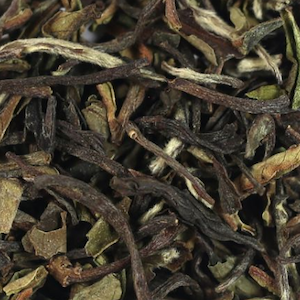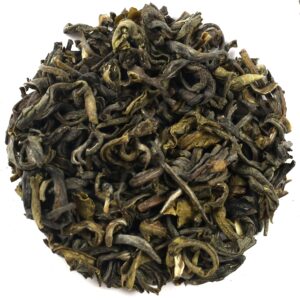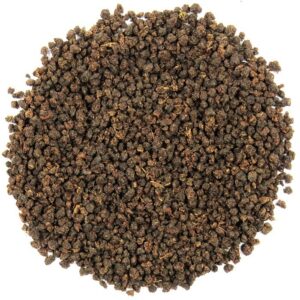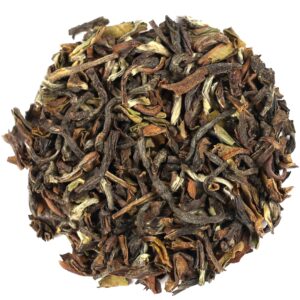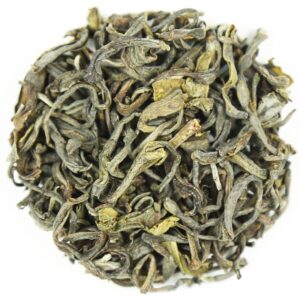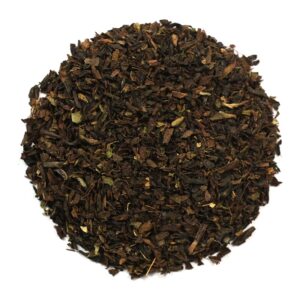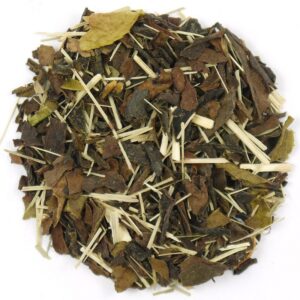Nepali Teas
Discover the enchanting world of Nepali tea. It’s a hidden gem in the majestic mountain ranges of Nepal. Our online store is proud of this exquisite selection. We bring it right to your doorstep. Our tea collection comes from the lush gardens of Nepal. It promises unmatched rich flavors and aromas. Are you a tea connoisseur?
Or, are you looking for a delightful new brew? Our Nepali tea range offers the perfect blend of tradition, taste, and tranquillity. Join us on a serene journey through the heritage of Nepali tea culture.
Showing 1–12 of 19 results
-
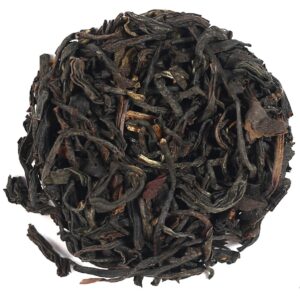
Golden Nepal Black Tea
From £2.81— or subscribe and save 10%Select options This product has multiple variants. The options may be chosen on the product page -
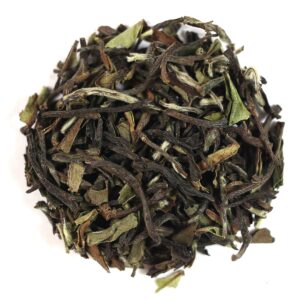
Nepal Himshikhar Black Tea Organic
From £4.05— or subscribe and save 10%Select options This product has multiple variants. The options may be chosen on the product page -
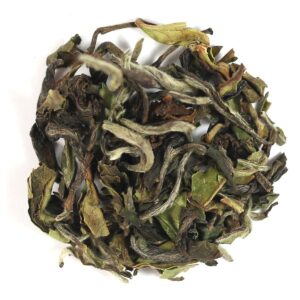
Nepalese Jun Chiyabari Tea First Flush 2020
From £6.17— or subscribe and save 10%Select options This product has multiple variants. The options may be chosen on the product page -
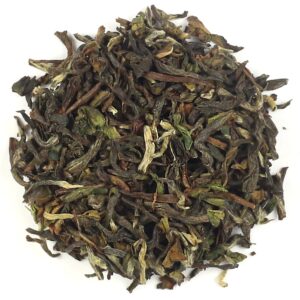
Nepal 2nd Flush Shree Antu Black Tea
From £4.25— or subscribe and save 10%Select options This product has multiple variants. The options may be chosen on the product page -
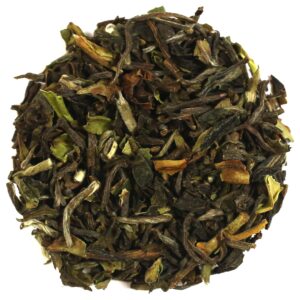
Nepal Sakhira Second Flush Tea SFTGFOP1
From £3.36— or subscribe and save 10%Select options This product has multiple variants. The options may be chosen on the product page
History of Tea in Napal
Tea has a rich history in Nepal. It is fascinating and closely tied to the country’s culture and economy. Tea cultivation in Nepal began in the late 19th century. The British introduced it to the region. They saw the potential of Nepal’s climate and soil for tea.
Tea growers first built tea estates in the eastern districts of Nepal. Ilam was the centre around which they were built. Ilam is still known for producing some of the world’s best teas. Tea farming has spread over the years. It has spread to other parts of the country. These parts include Dhankuta, Terhathum, and Panchthar.
Fast forward to today. Nepal’s tea industry has flourished. It has gained international acclaim for its high-quality organic teas. The Himalayan region has unique geography. It gives Nepal tea a special flavor and aroma. This sets it apart from other teas.
The industry is critical to Nepal’s economy. It does this through exports and by supporting thousands of families in rural areas. It helps their livelihoods. Nepali tea has a rich history. It continues to have a big impact on the global tea industry.
Tea Gardens in Napal
The tea gardens in Nepal are not just farms. They are like vast green canvases that cover the hills. They are mainly in Ilam, Kanyam, and Dhankuta. These gardens are more than just sources of livelihood. They represent a deep tradition woven into Nepali culture.
Tea cultivation and production here mix old and new techniques. They ensure every leaf tells its own story.
People have passed down old ways for picking and processing tea for generations. The careful process starts with picking tea leaves. They are usually the top two leaves and a bud. This happens early in the morning to keep their delicate flavors and aromas. This picking is selective. It ensures only top leaves are chosen for processing.
After the harvest, the leaves wither, roll, ferment, and dry. Each step is carefully monitored to enhance the tea’s unique traits.
For instance, the withering process reduces moisture in the leaves. This makes them pliable for rolling. The rolled leaves are then allowed to ferment under control. This step is critical. Here, the tea develops its colour and flavor. Finally, the tea is dried to halt the fermentation process, locking in the rich flavors and aromas.
Tea gardens also use organic farming methods. They avoid chemicals and pesticides. This practice saves the environment and preserves the tea’s purity and natural taste. This focus on organic farming has combined with the traditional handcrafted tea approach. It has made Nepali tea a premium product in the world market.
The tea gardens of Nepal are living museums. They showcase the rich heritage and changing practices of Nepali tea growing. They stand as testaments to local farmers’ dedication. The farmers bring the world an unmatched cup of tea. They do so through their tireless efforts and adherence to tradition.
Types of Tea Produced in Napal
Nepal is famous for its many exquisite teas. Each has a unique flavor and aroma. Among the most popular types are:
- Orthodox Tea: Traditional and highly regarded. A careful process of withering, rolling, fermenting, and drying makes it. This method preserves the integrity of the leaf, resulting in a fuller-bodied flavour. It is further divided into black, green, white, and oolong teas. Each type offers a distinct taste.
- CTC (Crush, Tear, Curl) Tea: CTC tea, which has a granular form. CTC tea is primarily used for tea bags. It is known for its strong, bold flavor. It is popular among those who prefer a robust cup of tea.
- Nepali Green Tea: Harvested and quickly processed to prevent oxidation. It is known for its fresh flavor and high antioxidants. It has a subtle taste with floral notes. This makes it a favourite among the health-conscious.
- Silver Tips and Golden Tips: They are made from the very young leaves and buds of the tea plant. These leaves are known for their light, delicate flavors and aroma. Nepal Silver Tip Tea are usually white teas. Golden Tips fall under the black tea category. Each presents a luxurious tea-drinking experience.
The diversity of tea produced in Nepal caters to a wide range of palates. Making it a treasure trove for tea enthusiasts around the world.
Nepal Tea Ceremony
The Nepal Tea Ceremony is a deeply rooted cultural tradition. It captures the essence of Nepali hospitality and the central role of tea in everyday life. Japan has formal ceremonies. China has gongfu tea rituals. In contrast, the Nepali tea ceremony is informal. It embodies a sense of community, warmth, and sharing. It reflects Nepal’s rich culture. It draws from its diverse ethnic groups and their unique ways of life.
History of the Nepal Tea Ceremony
The history of the tea ceremony in Nepal is intertwined with the country’s history of tea cultivation and consumption. Tea was introduced in the late 19th century. People then developed many ways to prepare and consume it. These ways became key parts of local customs and festivities.
In fact, offering tea to guests is a sign of respect. It is a custom across Nepal’s diverse communities. Over time, many parts of the country have raised this practice to a ceremonial level. It symbolises unity and shared joy.
Conducting a Nepal Tea Ceremony
The Nepali tea ceremony has no rigid structure. But, people commonly observe certain elements. This makes the experience both unique and inclusive. Here’s how to conduct a ceremony, infused with tradition but adaptable to the modern context:
Steps Taken
- Prepare the Space: Set up a clean and comfortable area where guests can sit close. They should sit on cushions on the floor to create an intimate atmosphere. Decorate the area with natural elements like flowers or leaves. This will honour the tea’s natural origins.
- Selection of Tea: Choose a high-quality tea. Considering the preferences of the guests. Orthodox tea, Green Tea, Silver Tips, or Golden Tips are all excellent choices. Make sure the tea is from good gardens. This way, it will be authentic.
- Heating Water: Heat water to the appropriate temperature. Depending on the type of tea being served. For example, green teas need cooler water (around 80-85°C) than black teas (95-100°C).
- Rinsing the Utensils: Rinse all tea utensils with hot water. This not only cleans the utensils. It also warms them up and keeps the tea hot.
- Tea Preparation: Add tea leaves to the teapot, using about one teaspoon per cup, plus one for the teapot. Pour hot water over the leaves and allow them to steep. The steeping time depends on the type of tea. For instance, green tea might only need 2-3 minutes, while black tea might need 3-5 minutes.
- Serving the Tea: Once the tea is ready, pour it into cups. Pour it in a circular motion from one guest to the next. This symbolises the flow of energy and connection among those present. Begin serving from the eldest or most respected guest as a sign of honour.
- Enjoy the Tea: Encourage guests to hold the cup with both hands. They should savour the aroma before taking small sips. This moment should be silent or have soft conversation. It lets everyone fully experience the tea’s flavors and the tranquility.
- Discussion and Reflection: After enjoying the tea, open the floor for gentle conversation. This is a great time to reflect on the shared experiences. We can discuss the tea’s qualities or enjoy each other’s company.
The Nepal Tea Ceremony is more than just drinking tea. It’s an act of communion, a way to welcome guests and celebrate the beauty of simplicity and the art of slow living. It blends tradition and togetherness. Every sip is a testament to Nepal’s rich culture and the timeless allure of its teas.
So, whether you’re in Nepal or just at home with a cup of Nepali tea, take time to embrace the spirit of the Nepal Tea Ceremony. Connect with others over this beloved beverage.

 Loose Leaf Tea
Loose Leaf Tea Pyramids
Pyramids Tea Bags
Tea Bags Africa
Africa Assam
Assam Ceylon
Ceylon Chinese
Chinese Darjeeling
Darjeeling European
European Indian
Indian Japan
Japan Nepal
Nepal South East Asia
South East Asia Ayurveda Tea
Ayurveda Tea Black Tea
Black Tea Chai Tea
Chai Tea Flowering Tea
Flowering Tea Fruit Tisanes
Fruit Tisanes Green Tea
Green Tea Herbal Tea
Herbal Tea Matcha Tea
Matcha Tea Oolong Tea
Oolong Tea Organic Tea
Organic Tea Pu erh Tea
Pu erh Tea Rooibos Tea
Rooibos Tea White Tea
White Tea Asian Coffee
Asian Coffee Caribbean Coffee
Caribbean Coffee Central American Coffee
Central American Coffee South American Coffee
South American Coffee Coffee Blends
Coffee Blends Decaffeinated Coffee
Decaffeinated Coffee Espresso Coffee
Espresso Coffee Ethically Sourced Coffee
Ethically Sourced Coffee Flavoured Coffee
Flavoured Coffee Organic Coffee
Organic Coffee Single Origin Coffee
Single Origin Coffee Chocolate 1
Chocolate 1 Chocolate 2
Chocolate 2 Chocolate 3
Chocolate 3 Chocolate 4
Chocolate 4 Chocolate 5
Chocolate 5 Chocolate 6
Chocolate 6 Chocolate 7
Chocolate 7 Chocolate 8
Chocolate 8 Chocolate 9
Chocolate 9 Loose Tea Filters
Loose Tea Filters Tea Accessories
Tea Accessories Tea Bricks
Tea Bricks Tea Caddies
Tea Caddies Tea Caddy Spoons
Tea Caddy Spoons Tea Gift Ideas
Tea Gift Ideas Tea Infusers
Tea Infusers Tea Strainers
Tea Strainers